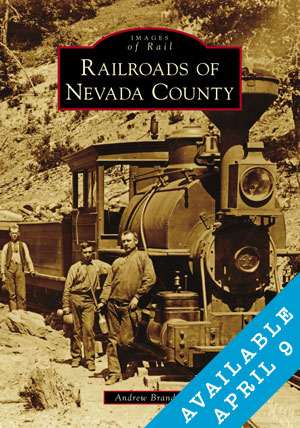

Dayton, Sheridan and Grand Ronde Railway.
By Andrew Brandon.
D uring the early 1870s the farmers of Yamhill and Polk counties had been largely ignored by Oregon's pioneer railroads. Long promised connections they were bypassed by the
Oregon and California during the late 1860s. In 1872 the Oregon Central (West Side Company) reached St. Joseph near the Yamill River, shortly there after the line collapsed
financially disapointing residents of the counties. Prior to the construction of railroads in oregon, the Willamette River provided a natural waterway for famers of the
Willamette Valley but often the wagon roads to river ports were difficult to travel and during the winter they were nearly impassible.
Left with few alternatives a group of farmers in Yamhill and Polk counties lead by Isaac Ball took it upon themselves to organize a narrow gauge railroad in the fall of 1877.
At a meeting in Amity on October 20th a committee was created to report on the practicability of the plan. On November 17th the committee submitted their report estimating the
construction cost of the road around $150,000 based on costs of similar efforts by roads in the Midwest and would serve 300,000 acres of land producing 1,000,00 bushels of wheat
annually.
The report went on to state:
"Let every farmer figure for himself. Let him count the time it takes to haul his grain away to Dayton now; count the wear and tear of himself, his teams and the harness and wagons; and the loss in the prices of grain in not being handy to the market to catch it at the top notch. Let him also count the increased cost of all machinery, merchandise, salt, iron, lime, etc., that must be hauled from Dayton or Saint Joe. And then let him consider how much more grain he could raise if he could save the time spent in hauling off his crop to Dayton, and put it on the farm in fall planting."
With the incorporation of the Dayton Sheridan and Grand Ronde Railway Company on November 14th, 1877. The proposed line would connect Dayton and its steamboat landing with Sheridan some 20 miles to the west with a branch serving Dallas to the south. At its onset, directors of the company were: B.B. Branson, President., Ellis G. Hughes, Sylvester Farrell, W.S. Powell and F.E. Beach. George Joseph Gaston, well known railroad promoter attended the two meetings at Amity and subscribed to one half of the 2000 shares. He was authorized to canvass the farmers so as to enlist them to make pledges. The pledges were payable in three instalments, at specified stages of construction, were to be refunded by the railroad in three payments, namely; November 1 1880, November 1 1881 and November 1 1882. These payments were to made in the form of freight orders or script, the railroad was to redeem the pledges by rendering an equivalent value of railroad service. This freight script was later held chargeable to the railroad by the supreme court of Oregon and $61,000 was refunded. The heaviest financing was performed by the creditor that supplied the rails the Pacific Rolling Mill Company of California It accepted three mortgages as follows:
| Rails for 20 miles mortgage, executed: November 5 1878 | $63,724.56 |
| Rails for 12 miles to Dallas, executed: December 4 1878 | $37,134.00 |
| Mortgage, executed: May 7 1879 | $4,058.00 |
| Total: | $93.916 56 |
In July of 1878 the first of the two locomotives 'Pioneer' was brought to Dayton by steamer. The little engine weighed 21,200 pounds, with 31" drivers. August saw the arrival of engine #2 and the last engine built by the National Locomotive Works, 'Progress'. Freight equipment consisted of a group of flat cars some of which were converted into makeshift passenger cars. The line between Dayton and Sheridan was opened on October 24th, 1878. Hastily constructed and with no ballast train speeds did not exceed 12 or 15 miles per hour. By the end of 1878 the railroad was unable to make its mortgage payments and the Pacific Rolling Mill Co. filed suit on January 23rd, 1879 with George Ravette appointed as reciever. A group of investors from Scotland, headed by William Reid purchased the railroad from the Pacifc Rolling Mill Co. On June 2nd, 1879 the railroad changed hands to a company controlled by Scottish interests called the Willamette Valley Railroad Company, at this time the Dayton Sheridan and Grand Ronde was dissolved. By 1881 the Dayton, Sheridan and Grand Ronde became part of the Oregonian Railway system, and was eventually standard gauged.
Carey, Charles Henry. History Of Oregon. Chicago - Portland: The Pioneer Historical Publishing Company, 1922.
Fletcher, David. "The National Locomotive Works." PacificNG.Com September, 2009.
Hilton, George. American Narrow Gauge Railroads. Stanford University Press, 1995.
Scott, Leslie M. "History of the Narrow Gauge Railroad in Willamette Valley." The Quarterly of the Oregon Historical Society. Volume 20, Number 2. Portland: The Ivy Press, 1919.
Reference Material Available Online:
Roster Information.
Steam Locomotives.
| Number | Name | Wheel Arrangement | Builder | Builder No. | Disposition |
| 1 | "Pioneer" | 2-4-0 | National Locomotive Works | 259 | To Oregonian Ry. 1881 |
| 2 | "Progress" | 2-4-0 | National Locomotive Works | 260 | To Oregonian Ry. 1881 |
Unknown Number of Flat cars.
Passenger Equipment.Earliest passenger equipment reported to be converted flat cars.
Maps.
Dayton, Sheridan & Grand Ronde Railway
by Scott Gavin.  500kb
500kb
Showing route from Dayton to Sheridan, 1877-1878.
Dayton, Sheridan & Grand Ronde Railway
by Scott Gavin.  600kb
600kb
Showing route from Dundee to Smithville, 1879-1880.
Photographs.
Collected Dayton, Sheridan & Grand Ronde Photographs.
Images collected from private collections, libraries and historical societies.



